New Grand Viaduct Huge Improvement, Development Opportunities Remain
Several years ago I suggested an urban bridge over the train tracks at Grand, storefronts lining each side of the bridge. These would be built on the ground below and designed to have a floor level even with the bridge. With the old bridge out of the way we can see this was entirely possible — only 3-4 train tracks have to be crossed and combined with Scott Ave the bridge span would’ve been 250 feet for so.
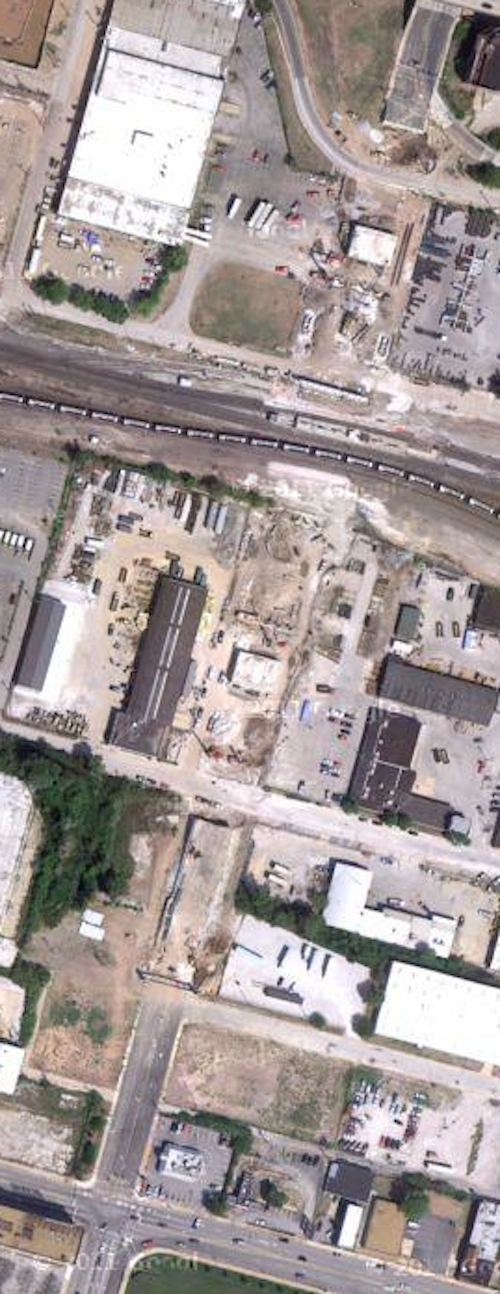
But the new bridge wasn’t designed with that in mind. However, the spans aren’t as long as the prior structure because previously open areas were built filled-in.
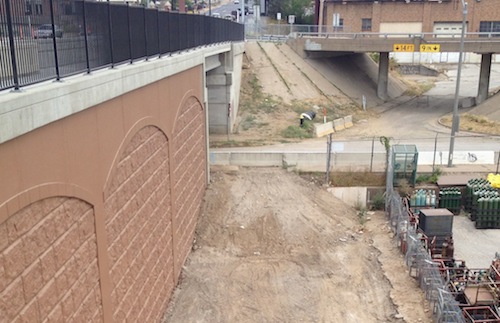
As you can see from the above image it’s just ground next to the viaduct, it’s not spanning the Mississippi River! Hold that thought though while we take a look at what was replaced and what was built.
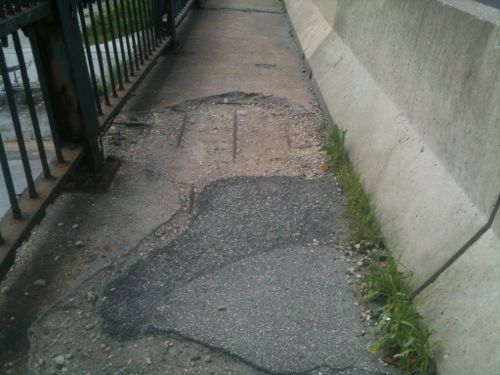
Crossing the old bridge/viaduct as a pedestrian was a miserable experience. It was narrow and at the center it got crowded with transit riders for the #70 (Grand) MetroBus and MetroLink.
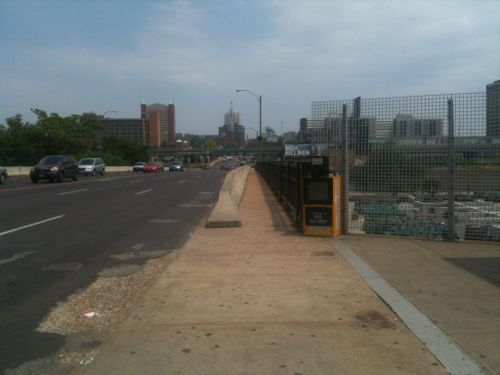
Now it’s a much better pedestrian experience!
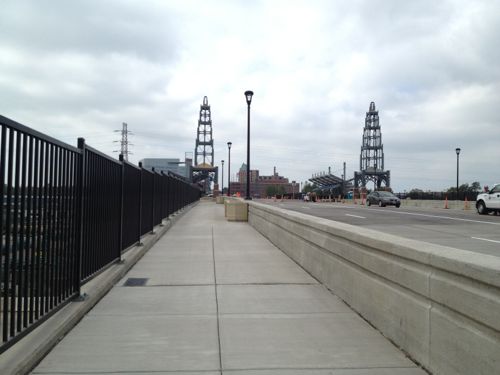
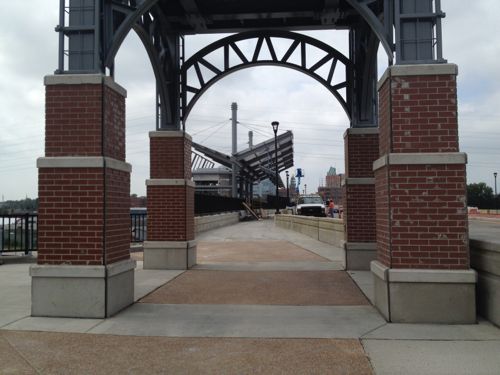
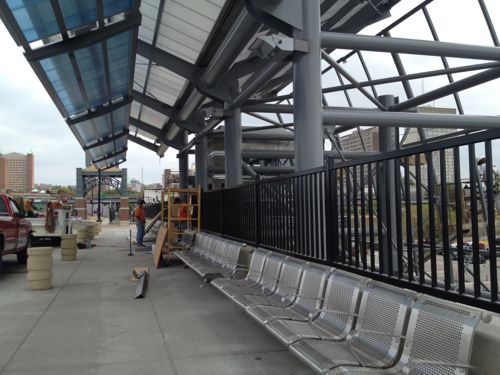
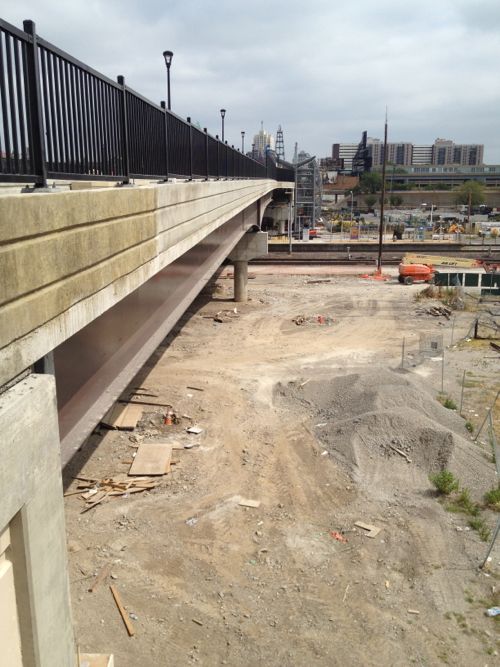
Ok, I like the new viaduct but it’s still a long distance from end to end — I’d still like to see structures built up next to the bridge over time. Next to the open section shown above might be problematic, but the earlier area near Scott Ave shouldn’t be difficult. However, a building foundation next to the foundation for the fill wall might be challenging, I’m not an engineer.
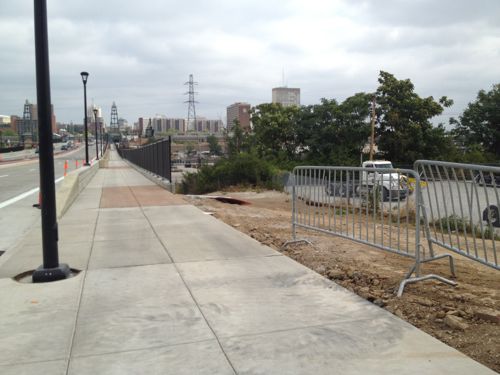
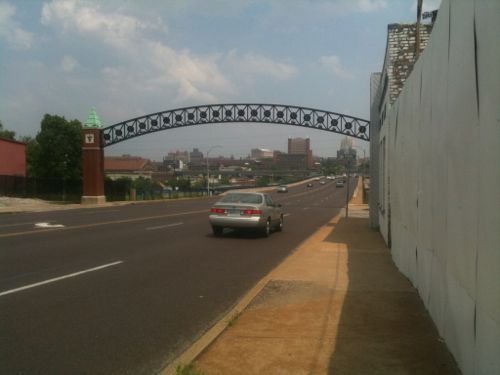
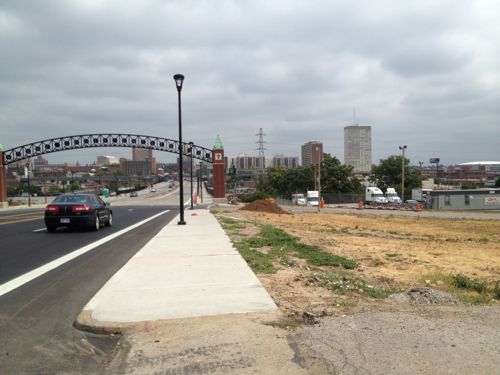
The old sidewalk was narrow and the new sidewalk isn’t much wider, it also lacks street trees. I’d like to see new buildings north and south of Papin St but I don’t think they should abut the sidewalk. Keep them back 10-15 feet, not 75+ feet the way Saint Louis University tends to do. Since the above is at grade and it won’t have on-street parking to separate pedestrians from traffic it really needs to have street trees and more width.
Remember that SLU wants more students walking from the main campus north of the viaduct to the medical campus to the south. The plants on the viaduct will help but we need street trees between cars and pedestrians where possible and buildings to give a sense of enclosure. This will be easier to accomplish on the west side so let’s cross Grand and have a look.
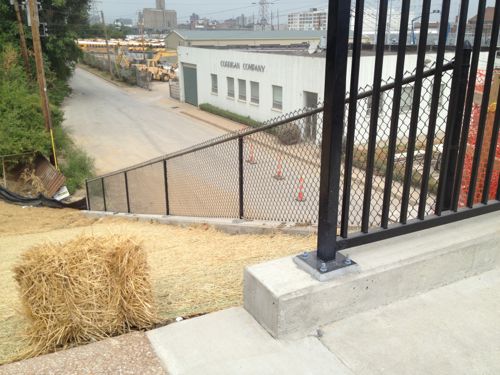
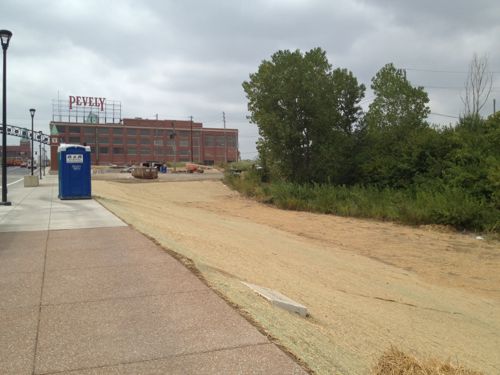
Unfortunately with SLU involved and their plan to raze the Pevely building in the background I’m not optimistic about the future of this area. It’ll likely be much like walking next to SLU. Perfect manicured green grass and buildings set back 100 feet or more from the sidewalk, totally anti-urban rather than appropriate transit adjacent development.
Hopefully I’m wrong and good urbanism will get built on either side of Grand.
— Steve Patterson
Your closing thoughts are probably correct – with SLU involved, I doubt that you’ll see anything built next to the bridge. But you’re also ignoring the reality, especially when it comes to retail, that most customers want to drive to their stores. The city has made NO provisions for on-street parking on the new viaduct, probably would be highly unreceptive to modifications to / “curb cuts” on the new structure (to access private parking directly from Grand), and has made it confusing and difficult to access streets below the viaduct. Why would anyone want to spend more money here, dealing with the challenges of the third dimension, when they can build much more easily simply by choosing a different site just a few blocks to the north or the south?!
I get it, visually and from a pedestrian’s perspective, lining the viaduct with storefronts would be mahvelous. But instead of throwing out fantasies, how about pushing ideas that might actually happen? There’s a dearth of retail on Grand north of Delmar (Grand Center) and between I-44 and Arsenal (Compton Heights, Tower Grove) that is potentially much more viable. Chouteau Avenue, both east and west of Grand, could become a boulevard and a great retail street. Add in the reality that the railroad isn’t the only obstacle to urbanism here – there’s the bridges over Forest Park Parkway and I-64, along with their access ramps, as well – and Grand between the two campuses remains much more attractive to cyclists and motorists than it does for pedestrians. You simply can’t change the fundamental reality that it’s still half a mile between Laclede and Chouteau, backed up by industrial, not residential, uses!
A few small retail spaces in the bases of buildings near the bridge would work ok if those buildings contained workers, researchers or residents. And yes fundamental realities can be changed, the industrial areas are slatted to become bioscience research areas.
People do realize that SLU’s Doisy Research Building is a Biocontainment level 3 building….these places require secured access. While I don’t envision other research buildings to be built to a level 3, any research level building(s) will trump public access/retail.
Secure buildings can have small retail spaces fronting onto a public street without problems.
So says you. the Federal Goverment says otherwise. But irregardless, small retail equals parking spaces. And like Adam says below….there is a big difference between wanting to and having no practical alternative. And those wanting to, will just drive down the road if it means they don’t have to walk more than a few feet.
Then put little buildings at the sidewalk to sell water and coffee to transit users and pedestrians crossing the bridge and put the research buildings behind.
How ’bout some really little “buildings”, aka vending machines? That would better match supply and demand . . .
I have zero desire to limit my thought processes to your narrow view of what St. Louis is snd will always be. I’ve seen much positive change in the last 22 years, I know that can continue.
This coming form the king of sweeping generalizations.
Steve puts a great deal of work in keeping this blog running for the community for years. And your contribution to the community is what? Your comment adds nothing, it is meaningless and shows you don’t read the posts.
I can’t tell how ridiculous your vending machine comment sounds. How can you not know that it is possible to plan for densities that can support both commercial shops and transit? It is one of the most basic principles of city planning. This is a major transit stop for god’s sake. And it should be even more important except for incompetent leadership.
In the hands of knowledgeable planners and architects the intersection of Grand and Chouteau would be a bustling urban intersection, with many people riding transit.
Under the hands of city government and SLU it is an urban dead zone. It is a modern urban disaster because it impacts the larger city so deeply.
Which is exactly why vending machines make sense now! We have a customer base and we apparently have identified a demand for cold beverages. We can probably sell, what, on average, 100 bottles or cans per day? Assuming, generously, $0.25 profit per unit, that’s a whole $25 in profit per day. If you pay someone minimum wage for 4 hours, there goes your whole profit, and more. In contrast, a vending machine is there 24/7 and isn’t expecting a paycheck. Why do you think most highway rest areas have vending machines instead of manned soda fountains?!
Yes, better planning and higher densities would make any retail operation here much more viable. But, as you so succinctly put it, this IS a dead zone, at least currently, and most likely into the foreseeable future. Do we let transit riders go thirsty, now, waiting for better? Or, do we meet their immediate needs? When the station reopens next month? Vending machines are absolutely not permanent nor the last and final option, nor was I suggesting that. But whether it’s kiosks or food trucks, any operation that is staffed by humans in search of a paycheck will have to be profitable for it to be there for more than a few months!
How about a water fountain? Cheaper, healthier, and more inviting for transit users.
Why is parking needed? There is a crowded bus line, light rail, and plenty of room for dedicated bike lanes connecting north and south grand. This should be St. Louis’ strongest transportation corridor. With SLU nearby there’s thousands of students who are healthy enough to walk a few blocks. If they had a reason – with a design that made it possible and fun – they would do it.
“But you’re also ignoring the reality, especially when it comes to retail, that most customers want to drive to their stores.”
Says who? There’s a big difference between “wanting to” and having no practical alternative.
I’m not sure I follow your comment. I get the first part – you disagree that most customers want to drive – we have different perspectives, but I’m not sure that I get the second part – having no practical alternative. Are you saying that the transit dependent need more stores at transit stops? That taxis, call-a-ride, ZipCar, biking and/or walking are not alternatives? That transit needs to be routed closer to existing shopping options?
My experience is that if there are customers and they have money to spend, and a retailer can make a profit, the retailer WILL figure out how to serve those customers. The challenge facing many retailers in many parts of our fair city, however, is the making a profit part. Whether it’s making no profit or having the opportunity to make more profit somewhere else, most retailers are selfish and greedy – they’re going to follow the money. Want more retail on Grand? Then bring more customers AND have them spend more!
If your customers “have no practical alternative” primarily because they’re poor, they obviously will not be great customers for most retailers. When I was a poor college student, most of my limited disposable income went to pizza and albums. I didn’t buy a lot of clothes or organic food, nor did I buy furniture or jewelry. We all know that record stores are going the way of the dodo bird, which leaves a limited range of retail / food alternatives that will appeal to most SLU students.
I am not sure I follow your comment. Do retailers have anything to do with providing transportation infrastructure? No, government does that. St. Louis’ does a horrible job at providing practical alternatives to the car and for the most part incentives car use whenever possible.
Firstly, I understand that density of retail services depends on population density if that’s what you’re getting at, but it still has absolutely nothing to do with whether or not people WANT to drive. My point is that people in Saint Louis have few choices other than driving REGARDLESS of what they WANT to do. Obviously biking and walking are alternatives but in most cases STL doesn’t have the business density to make such trips practical. Good luck finding car-sharing (WeCar) outside of downtown. And taxis? Sure I can afford to pay $10-$20 bucks every time I need to go anywhere. No problem.
I really don’t understand your logic, though. SLU students WANT to drive everywhere because record stores are dwindling? I think you’re substituting your own preferences for those of everyone else. I don’t know why St. Louisans would be so different than people in cities that are denser and better connected by transit. I think the difference is the infrastructure, not the people.
Not everybody can afford a Taxi. Call-A-Ride within the city limits are only for the disabled. Not everybody has a credit card to rent a ZipCar. That may be an alternatives for you but not all. I do all my shoping on public transit. I’ve taken T.V.’s, computers, bookshelves home on public transit because I have no other way to get it to my house. I shop a Target on Hampton and K-Mart on Manchester because they are in the city. It’s only suburban type thinking that causes the the retail stores to locate in the suburbs. I only shop in the county because what I need I can’t find it in the City because of norrow thinking minded people.
I have to agree with Adam, there is no practical alternative to customers driving to stores. A good example is the fire that just happened on Lindell, apparently most of the apartment dwellers were students. SLU has apparently passed on an opportunity to build apartments and condos at Grand and Chouteau for students, workers at the hospital adjacent to the train station. Such a design would generate opportunities for stores and shops in the area while still allowing for medical facilities.
Many, many cities take these types of approaches to build successful transit systems for a population that uses transit readily. Not to mention most students would not have autos.
So dominant car usage is not just some slam dunk choice, but rather the result of poor design. As an architect I would hope you value design and its ability to make something beautiful and desirable.
With the investment in the bridge now coupled with the investment in rail makes the intersection at Grand and Chouteau a colossal failure on the part of SLU and City Government. Massive public investments are ignored and the guiding philosophy of urban planning in the city seems to be “whatever”.
I respectfully disagree. Near any college there will be more students than regular residents/pedestrians. You make a blanket statement that SLU has passed on living options for students. You know this how? One of the things SLU has done has secured the land for future uses. Would Fr. Biondi win more fans and garner more support if they released, say a 20 year plan? Absolutely. Even I wish that. Could he build something now? Yes, but would it be functional in 10 years? that is the question we can’t answer.
But Fr. Biondi is no common business man. He is very smart and holds his cards close. And why wouldn’t he? If we knew that condos were going to be built 5 years down the road, who wouldn’t buy land surrounding the project and hold it ransom? I believe that within the next 10 years the hole between the Med Center and the main Campus will be filled in. But even Fr. Biondi and their 600 Million endowment can’t do it all and can’t do it over night. And let’s not forget the economic realities of schools right now….enrollment will be decreasing, tuition rates are stalling out, student aid is becoming scarcer, and that endowment is subject to the whims of the financial markets. Bottom line is that there is a whole lot of uncertainties in the education field right now and will be for the next few years.
I also think that the SLU and City Goverment failure that you speak of is just because it doesn’t meet a particular poster’s desires. Everyone wants something done and done yesterday.
And finally, just because a student walks does not mean that they (and all students) have limited income for “pizza and albums”. And again, well it is nice to demand pedestrian options, the fact is that the greater majority will still drive and not walk. And this isn’t Tokyo or London. This is America….the highest obesity rate in the world. Our nation is fat and lazy. Build to that, and get blamed for enabling, build to increase “healthy” options such as walking and biking and the risk for failure is greater.
I’m not saying build to the common denominator nor just allow whatever. What I am saying is that these issues are part of a very complex system and no one entity can solve them alone.
“If we knew that condos were
going to be built 5 years down the road, who wouldn’t buy land
surrounding the project and hold it ransom?”
Is that really his job? I understand if he has his eyes on a piece of land for needed expansion, but what business does the president of a Jesuit university have speculating for profit? I don’t understand how that could possibly coincide with the university’s mission statement.
Yes it is, it is called investment. that helps keep the University in the black. If you want him out of the investment business, then go and tell that to Wash U. (when they own more property than SLU). And retail around transportation corridors….I get that, I think it is very smart thing to do….now take that outrage and head down to BJC, who’s Metrostation is under the buildings with NO retail around. Compared to SLU…going from the station, you run into the first retail (doesn’t matter what) at SLU than you would walking the same distance from BJC’s station.
And I do make the claim of obesity. Re read my last sentence. How many developers will build in the “hopes” that a pedestrian customer base will appear? Not many. It’s back to which came first agrument. You can think I’m wrong but some will think I’m right. THAT is the reality. Now how do you combine the two to make a project successful?
tell what to Wash U? they’re a private, for-profit, non-denominational university and nowhere near the new viaduct. what W.U. does has no bearing on this discussion. neither does BJC. either way, i think you’re being disingenuous about their respective proximity to transit, businesses, and walkable neighborhoods. at BJC you cross the street and your in the CWE. at WU main campus you walk a few blocks and you’re in the loop. just because you encounter a single business (what, captain D’s? it does matter, actually) closer to the SLU metro stop than to the BJC/WU stops does not mean SLU’s environment is comparable. and yes, i realize SLU is located in an urban dessert — one partly of their own making IMO (and yes i know your feelings on my opinion so lets not waste time arguing about it again). the fact that more people (including a lot of students) walk around in the CWE and in the loop pretty much validates my point, though.
obesity. so because some americans are obese nobody will walk? tell that to NYC, Chicago, Philly, Boston, San Fran, DC, Baltimore, New Orleans, etc. Philly was recently the fattest city in the U.S. maybe it still is. take a look at the number of people out on the sidewalk next time you’re there. and as Doug mentioned, it’s not the job of developers to build infrastructure. it’s the city’s job. pedestrian-friendly infrastructure = more pedestrians. the evidence is overwhelming. THAT is reality.
now take that complacency and drive your car everywhere. (sorry, i had to. in response to my supposed outrage.)
You don’t get it. Whether Wash U is profit or not is not the issue and neither is BJC. We are talking about the intermingling of pedestrian and retail. SLU===first off, the metro station is at the North end of the bridge, not the south end. Within 200 feet of that was the DelTaco and soon to be Starbuck? At BJC, you get out and you have to walk over 1500 feet to reach Tom’s Grill, the entrance to the CWE. THAT is proximity to retail. And if one wants to base things on $$$ SLU Hospital is approx. 200 Million business and is taxed, compare that to BJC’s 1.5 BILLION tax-free…and who should be doing more for the surrounding area????
Obesity….nice examples except they just don’t matter unless you live there. Next time you are at Target or Schuncks and you see someone getting out of their car, go up to them and say you know, people in New York or Chicago or Philidelphia walk to their stores, do you think they are going to say “gee you’re right, next time I will walk or take the bus”, or do you think they are going to say “so what???” Whether you like it or not, if you can convince a builder to build and favor majority of pedestrians over cars and such a project gets built, where do you think the majority of customers will head for? They will head to a store that has the same items and is more convenient for them. Look at Target at Hampton. It was fairly pedestrian friendly before the rebuild but they were short of parking. They knew they could not build more parking on the surface, yet did not want to give up the market, so they went down and built underground. A rather big investment to pacify Just drivers.
My point is that you can try and build all the ped. friendly retail you want, but unless you allow for drivers, it is going to fail….they will and do shop elsewhere.
Unbelievable. 200 feet vs. 1500 feet? Are you serious? GO LOOK AT THE MAP. The metrolink stop is NOT at the north end of the bridge, it’s right in the center. The distances are nearly the same and they’re both >> 200 feet. No, really. Do it now. Bring up the satellite views side by side at the same scale, compare the distances and surroundings, and then try claiming again that the SLU metrolink stop has better proximity to retail. Please, I need a good laugh. And you forgot about the W.U. Med School book store, which is considerably closer to the BJC metrolink stop than the saucer is to the SLU stop.
Moreover, YOU are the one that brought up Wash. U. and BJC. Not me. Remember? But while we’re on the topic, BJC is a NOT-FOR-PROFIT hospital while the Tenet-owned SLU hospital is a FOR-PROFIT institution. I would also argue that W.U./BJC does considerably more for their surrounding neighborhood than SLU hospital does for theirs. Go read about the The Washington University Medical Center Redevelopment Corp. Meanwhile SLU bulldozes any residential within a mile of their parking lots.
As for driving… I see. I offer examples but they’re just not good enough because people in STL are so fundamentally different than everyone else in the U.S. that even if it were practical to walk St. Louisans would instead choose to drive. Just because. Because you say so. Convenience is a matter of proximity and simplicity. Yes, if people have to choose between walking a few blocks to the store vs. driving a couple of miles to the store some will choose to walk. That is a fact and can be observed in cities with denser environments and better infrastructure. Period. And catering to other modes of transportation doesn’t preclude all driving, so I’m not sure what you hope to accomplish with your Target example. In fact, I think underground parking is fantastic for pedestrians. It lets the store remain closer to the sidewalk which makes the commute less treacherous for people walking/biking/getting off the bus across the street, etc. It’s too bad they didn’t put ALL their parking underground but some effort is better than nothing. How much do you want to bet that more people walk to the Hampton Target than walk to the Brentwood Target?
If people can’t get around without a car, they won’t try. If they can, some will. That is the observable, reproducible fact.
The old Target wasn’t “faintly pedestrian friendly”, the current Target is barely so. The underground parking was done not so they could have more parking, but because they wanted a larger store footprint.
“And again,
well it is nice to demand pedestrian options, the fact is that the
greater majority will still drive and not walk. And this isn’t Tokyo
or London. This is America….the highest obesity rate in the world.
Our nation is fat and lazy. Build to that, and get blamed for enabling,
build to increase “healthy” options such as walking and biking and the
risk for failure is greater.”
how is this a fact? there are so many counterexamples in more pedestrian-friendly cities throughout the U.S. that I don’t understand how you can make such a claim with a straight face. have you been to georgetown? cambridge? hell even here in charlottesville the foot traffic around the university is about 100x that around SLU. the difference is that those places are built for walking while midtown has been shredded. i don’t know how much more obvious it could be.
How do you know more people will drive than walk if there are reasonable options for walking?
Maybe it would be better to go to Chris Nagus and ask “Is this why we are broke”? A major investment in first light rail and then the Grand Ave Bridge, but only suburban dead zones are built around the train station.(by SLU) Fewer people use transit, fewer people walk. Why did we make an major investment in light rail or the Grand Ave Bridge in the first place if major institutions are going to pretend they don’t exist?
(Please compare how Wash U. integrated light rail with its campus vs. SLU who does everything possible to block effective transit for its students, and for the rest of the city).
Thanks for clearing up what the towers were for. They make a nice entrance to Fr. Biondi Boulevard! But seriously, this is such a great improvement. Now if only people will respect it and not urinate at the bus stops and all the other areas of the bridge. I’m sure when the plantings are finished it will be great!
Parking on the bridge? Retail??? Grand Bridge is not a parking lot. And there is a reason all that area under and around the bridge is industrial, has been industrial, and probably will stay industrial. Though I believe the idea for a Target next to the Amory was on the books until the economy tanked. Perhaps it will resurface. Sorry if it’s not be redevloped at the speed some would like.
As for the ‘darth of retail’ from Arsenal on up,… a lot of that part of Grand is small retail or residential. While it may look vacant, there is actually little developable land/buildings available…
Looks Amazing!!
Steve I agree and get your point. Thanks
One, this is Steve’s blog – he gets to say whatever he wants, even if it may border on being a fantasy. The rest of us are his guests – I appreciate that he both entertains other views and brings forward interesting topics for us to discuss (mostly in a very civil manner) pretty much every day.
Two, I’m a pragmatist. I’ve seen plans developed, I’ve seen plans implemented, I’ve seen plans modified and I’ve seen too many plans just end up on shelves. While the last can be interesting intellectual exercises, they usually consume resources that can be better directed toward projects that will actually happen. They can also burn out people who want to contribute to their communities and create serious distrust toward government, in general – unfulfilled expectations and unmet promises are poison to citizen involvement.
Three, I’ve been “on the other side”, serving on Denver’s transit board for five years and seeing how ineffective most governmental agencies are in the real estate and development game (unlike most private developers). Soliciting bids for vacant space, combined with substantial insurance requirements and politically-motivated quotas for “disadvantaged” businesses all conspire to sabotage the best of most intentions.
Four, I want to see the St. Louis region succeed. I don’t have a “narrow view of what St. Louis is and will always be.” If anything, I’m frustrated by much of what passes for “development” and “redevelopment” around here. We’re the 19th largest SMSA (2.8M), while Denver is the 21st (2.6M), yet our transit ridership is less than HALF of Denver’s (925,000 average weekday boardings* versus 2,115,000)! We’re hobbled by a political infrastructure that favors a narrow view focused, many times, on generating new sales tax revenues over anything else. We’re beholden to developers who are adept at playing our political “leaders” off against each other. We seem to have no problem leveling whole neighborhoods for new shopping centers yet we can’t seem to create a viable public transit system to serve our suburban areas.
And five, I’m a big believer in the golden rule – he who has the gold, makes the rules. Whether it’s the Grand viaduct or the Pruitt-Igoe site, it’s the private sector who will ultimately decide whether or not anything happens. In the past, the private sector saw more value in both sites than is evident today. The government can suggest, lead, legislate and/or create rules, but unless it’s going to write a check for some actual public use, the government can’t force anyone to spend money to build something they don’t want to on either site. What’s really going to need to happen, here and elsewhere, are incremental successes. We may not like what SLU has done, and is doing now, but they’re at least doing, and not just talking . . . .
*http://www.apta.com/resources/statistics/Documents/Ridership/2012-q1-ridership-APTA.pdf
Vending machines are not a solution to the design problem of Grand Ave Bridge and Rail Station. The title of the post includes the words, “development opportunities remain”. That is the problem to be solved. There are no strategic goals, no visions of what should happen at this site, (or in the city and region).
The vacant lands that are left are the north west and east corners of Chouteau and Grand Ave and another parcel on the other side of the bridge. (Although I wonder if a better long term solution wouldn’t put the entrance and exit off of the highway 40 across from each other, freeing up more land. simplifying traffic)
The City of St, Louis should take all of the remaining vacant property by eminent domain and offer it to developers willing to build density with apartments, condos, shops, hotels and so on.
It may be possible to create enough density at Chouteau and Grand to offset the pedestrian desert at the Doisy Center and the proposed medical center across Grand on the Southwest corner. Not a perfect solution, but one that impacts the Grand Ave Station and Bridge.
The question that remains is how to make the light rail station and bridge a success?
It is in the public interest to exercise eminent domain on the properties around the station. Not only does such action support the considerable investment in light rail and the bridge, it also supports lowering carbon footprints, while working against oil shortages.
The success of the Grand Ave rail station should be a major public goal.
I would not let SLU develop any more property near or adjacent to the Grand Ave Station. New developers must be held to standards. This means the public should know what is going on upfront, that is not the case now.
What works that supports mass transit and the major rail station on Grand Ave?
Whatever the solution, the apartment fire on Lindell indicates there is probably a large pent up demand for students, hospital workers and people who don’t have or want an automobile for apartments or condos.
Claims the vacant land at Grand at Chouteau are not valuable for development are dubious at best.
A cohesive planning approach that informs citizens will also attract developers. As it stands right now all of City and Regional Government along with major media are silent. That’s were everything stands except for the voice of Urban Review.
Otherwise no discussion, no democracy is the rule.